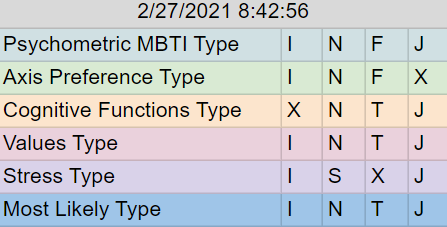Morpeko
Noble Wolf
- Joined
- Sep 20, 2017
- Messages
- 5,413
- MBTI Type
- LEFV
- Enneagram
- 461
- Instinctual Variant
- sx/sp

Hi! I'm Adorea, one of the admins of Dimensional Personalities and the creator of this test.
Thank you for the attention for our test, it's still in the trial stages and has much room for improvement (especially on the stress type). Just to clarify, in theory the stress type is supposed to show the same type as the "most likely type", based on reactions under loops and grips, etc; but I don't think that's accurate at the moment. One of the reasons may be mixing up shadow attacks from stress with grips, which is something I would like to change the wording of the questions/code in the near future.
I apologize for the inaccuracy of the test at this stage. A few of you have received the complete opposite duality type to your actual type, that's likely because the majority of the test (cognitive functions and values type) is based of working out which functions are in the main valued stack of the type and then working out the temperament of the type. If the test didn't correctly get your temperament but got the right valued stack, you'll likely get the duality type.
Regardless, thank you for the feedback of our test, I'll keep these in mind when I update its code once schoolwork becomes less busy.
(Sorry for sounding so formal)
What is main valued stack and what is temperament?
Which of teh 5 results do those correspond to?
The main valued stack is the dominant, auxiliary, tertiary and inferior functions of a type. It's the opposite of the shadow stack consisting of the shadow functions of the type.
Temperament refers to EJ/EP/IJ/IP. E.g. I'm an ENTJ, my valued functions are Te, Ni, Se and Fi (in that order), and my temperament is EJ. But the opposite type (ISFP) also have the same valued functions, just in different order.
The confusion with the temperaments would effect the cognitive functions and values types scores, the two major parts of the test.
All 5 results should align to a most likely type, with the exception of the first:
1) Psychometric refers to typing based on behavior, based on the axis like the 16 personalities model; it's barely counted in the calculation of a most likely type but there to contrast one's type based on functions and letters, for those new to mbti from 16p or other psychometric websites.
2) Axis preference refers to typing based on the core of the 4 letters, but stressing on preferences, not actual behavior.
3) Cognitive functions refers to typing based on which function one prefers to use, emphasizing on the cognitive function's definition as active thinking processes.
4) Values type refers to typing based on the function one values, based on the axis of valued vs unvalued (shadow) functions from Beebe's 8 function model.
5) Stress type refers to typing based on one's stress reactions, in mild or extreme stress, according to the theory on loops and grips.
Parts 2-5 all contribute to the most likely type score, but the percentage of how much each section contributes to the most likely score depends on the responses from the background information section.
It might be possible that the stressor test part currently gets the tertiary and inferior functions right instead.
Yes, that's also possible hmm. I'm not sure why that would be the case, but that seems right from the latest results. Maybe it's because it's hard to differentiate between loops/grips, and not everyone has experienced/aware of experiencing both.
The code for that section currently is questions about whether one acts in a certain way under a certain level of stress, and how much their responses align to the typical response of a type.
